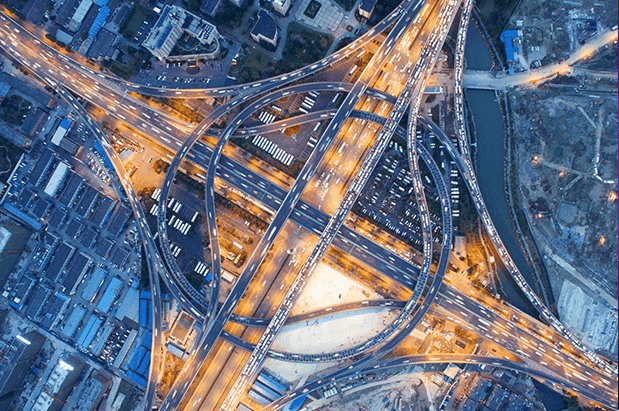Governments all over the world are battling hard to tackle the issues with traffic congestions and the rising pollution levels. They recognise that these factors are leading to a negative impact on the society. With people spending an excessive amount of time in commuting, there is a need to develop a smart transportation network powered by automatic asset monitoring, real-time traffic updates and forecasts, and best route planning based on weather conditions – all this is combined under the umbrella of Smart Mobility. The focus has now shifted from simply building new capacity to using the existing capacity smartly by using technology and optimising existing asset performance.
Speaking of India, over 30% of the Indian population lives in cities and by 2031, this number is expected to rise to 87%. To support the growing urbanization in the country, it has become essential to have smart transport systems. A study by NITI Aayog and Rocky Mountain Institute found that with the help of an electrically-powers, connected mobility system, India can save up to 37 percent of carbon emissions in 2030!
The Indian Government Initiatives
The government of India has set itself an ambitious target to make India a 100% electric vehicle nation by 2030. It’s various programs, including FAME (Faster Adoption and Manufacturing of Hybrid and Electric vehicles), are steps towards achieving this goal. In line with that, the government is allowing adoption of new mobility options and has also cut taxes on the lithium-ion batteries which are used in electric vehicles.
Under the Smart India Mission, the Government of India plans to make more investments in public transport systems and initiate transit-oriented development (TOD) across 100 cities. This will make the transport network well-connected, energy efficient, and will also substantially reduce the pollution levels. Nagpur, with its 200 electric vehicles, including taxis, buses, e-rickshaw, and autos, has earned the tag of India’s first city with electric mass mobility system.
Under its Smart Cities initiative, the government of India has allocated a substantial budget for the development of efficient public transport and urban mobility systems which include construction of roads, flyovers, and Mass Rapid Transport (MRT). Apart from this, there is also a sharp focus on the development of intelligent traffic management systems with technologies such as IoT, Artificial Intelligence, and Big Data.
Initiatives such as FASTag by the National Highways Authority of India (NHAI) and SMS alerts about traffic status on national highways are some of the other moves towards smart mobility.
India’s strategic strengths in IT, growing manufacturing base, government’s aggressive plans and investments in smart cities are all working in favor of this agenda.
Support from Automotive Giants
The automotive giants are putting in a tremendous amount of money and efforts in R & D in alternate fuel technologies and are working towards being compliant with the BS VI emission norms from April 2020.
- Suzuki Motor Corporation has announced that it will start the production of lithium-ion battery at its Gujarat plant from 2020. It also plans to launch its EVs under the cooperation with Toyota Motor Corp in 2020.
- Hyundai is working towards transforming itself into a smart mobility solutions provider. It has plans to release its all-electric Kona subcompact SUV in India next year. That apart, the company plans to launch its Nexo hydrogen fuel cell electric vehicle and two other electric vehicles in India.
- Ford is already in talks with infrastructure such as the traffic signals and working on leveraging big data and analytics solutions to address the urban mobility needs. In its approach, Ford believes that to rightly address the mobility challenges several systems need to work together and deliver the right solution.
- Tata Motors is the bidder with the lowest quoted price for the government’s order for 10,000 electric vehicles. The company, with its ‘One Tata Approach’, is working towards aggressively delivering cleaner mobility solutions.
- Mahindra, the pioneers of electric mobility in India, recently unveiled its Treo vehicle and reinforced its plans to make the EV segment adoptable for masses. Mahindra has also signed up a MoU with Auroville, a township in Tamil Nadu, to develop a holistic ecosystem of Mahindra’s electric vehicles, charging infrastructure, smart parking, and its software platform NEMO (Next-Gen Mobility).
MOVE – Global Mobility Summit
Niti Aayog (The National Institution for Transforming India) has very aggressive plans to completely transform and modernize India’s transportation sector. It’s latest event, MOVE – Global Mobility Summit, 2018, very boldly pushed the Digital India initiative in this sector. MOVE aims to position India as a key player in smart mobility to combat challenges across multiple modes of mobility (air, earth, water). A think tank is set to discuss and share how India can take the lead to de-risk fuel prices and dependency, control emission, improve public transport infrastructure, and adopt alternate energy (EV).
Inteliment was the only SME to be invited at MOVE. I was also invited to be one of the key speaker at the event. The event focused on electrification, alternative fuels, reinventing public transport, goods transport and logistics through data analytics as key themes. It is quite encouraging to see that the industry leaders, the government, and the automobile giants recognize that digitisation is the future of modern India.
At Inteliment, we are extremely excited to be a part of India’s this transformation and aim to actively participate in it.




